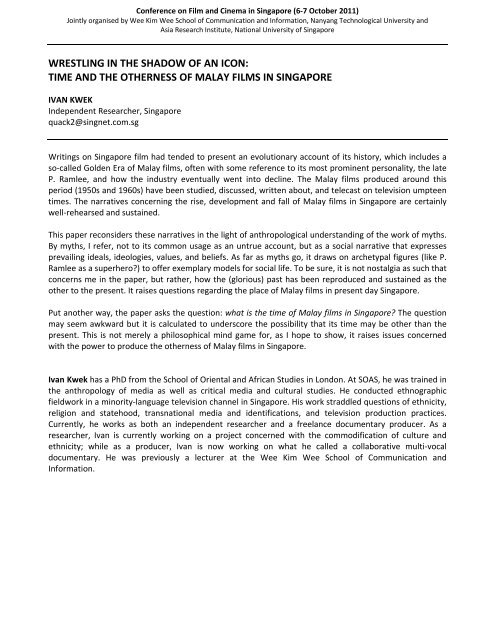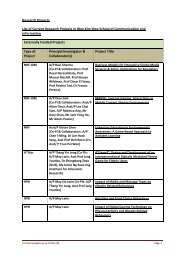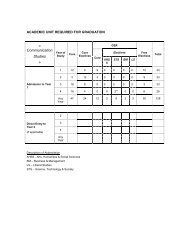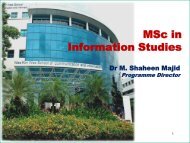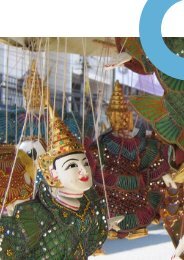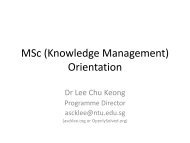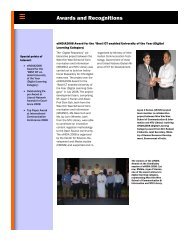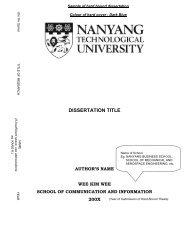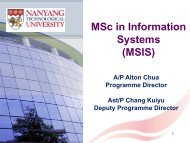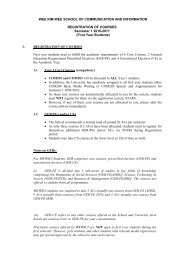Programme and Abstracts 4 Oct 2011 - WKWSCI Home - Nanyang ...
Programme and Abstracts 4 Oct 2011 - WKWSCI Home - Nanyang ...
Programme and Abstracts 4 Oct 2011 - WKWSCI Home - Nanyang ...
Create successful ePaper yourself
Turn your PDF publications into a flip-book with our unique Google optimized e-Paper software.
Conference on Film <strong>and</strong> Cinema in Singapore (6‐7 <strong>Oct</strong>ober <strong>2011</strong>)<br />
Jointly organised by Wee Kim Wee School of Communication <strong>and</strong> Information, <strong>Nanyang</strong> Technological University <strong>and</strong><br />
Asia Research Institute, National University of Singapore<br />
WRESTLING IN THE SHADOW OF AN ICON:<br />
TIME AND THE OTHERNESS OF MALAY FILMS IN SINGAPORE<br />
IVAN KWEK<br />
Independent Researcher, Singapore<br />
quack2@singnet.com.sg<br />
Writings on Singapore film had tended to present an evolutionary account of its history, which includes a<br />
so‐called Golden Era of Malay films, often with some reference to its most prominent personality, the late<br />
P. Ramlee, <strong>and</strong> how the industry eventually went into decline. The Malay films produced around this<br />
period (1950s <strong>and</strong> 1960s) have been studied, discussed, written about, <strong>and</strong> telecast on television umpteen<br />
times. The narratives concerning the rise, development <strong>and</strong> fall of Malay films in Singapore are certainly<br />
well‐rehearsed <strong>and</strong> sustained.<br />
This paper reconsiders these narratives in the light of anthropological underst<strong>and</strong>ing of the work of myths.<br />
By myths, I refer, not to its common usage as an untrue account, but as a social narrative that expresses<br />
prevailing ideals, ideologies, values, <strong>and</strong> beliefs. As far as myths go, it draws on archetypal figures (like P.<br />
Ramlee as a superhero) to offer exemplary models for social life. To be sure, it is not nostalgia as such that<br />
concerns me in the paper, but rather, how the (glorious) past has been reproduced <strong>and</strong> sustained as the<br />
other to the present. It raises questions regarding the place of Malay films in present day Singapore.<br />
Put another way, the paper asks the question: what is the time of Malay films in Singapore The question<br />
may seem awkward but it is calculated to underscore the possibility that its time may be other than the<br />
present. This is not merely a philosophical mind game for, as I hope to show, it raises issues concerned<br />
with the power to produce the otherness of Malay films in Singapore.<br />
Ivan Kwek has a PhD from the School of Oriental <strong>and</strong> African Studies in London. At SOAS, he was trained in<br />
the anthropology of media as well as critical media <strong>and</strong> cultural studies. He conducted ethnographic<br />
fieldwork in a minority‐language television channel in Singapore. His work straddled questions of ethnicity,<br />
religion <strong>and</strong> statehood, transnational media <strong>and</strong> identifications, <strong>and</strong> television production practices.<br />
Currently, he works as both an independent researcher <strong>and</strong> a freelance documentary producer. As a<br />
researcher, Ivan is currently working on a project concerned with the commodification of culture <strong>and</strong><br />
ethnicity; while as a producer, Ivan is now working on what he called a collaborative multi‐vocal<br />
documentary. He was previously a lecturer at the Wee Kim Wee School of Communication <strong>and</strong><br />
Information.


